Docked alongside HMS Belfast in the Pool of London, the futuristic RFA Proteus astonishes with a bridge so advanced it rivals the starship Enterprise.
I was lucky enough to see the ship this week, and its presence was striking—an auxiliary ship appearing massive next to the famed World War II cruiser; I did not expect that.
Upon invitation, I boarded RFA Proteus for an exclusive tour with colleagues from other defence news websites. The first stop on the tour was the flight deck, posed awkwardly at the top of the ship, a hangover from her commercial days. The impression here is that there’s no real use for it aside from helping to evacuate any potential casualties, which is, of course, very important.
The bridge, which was remarkable, was the second stop. One bridge area is dedicated to traditional ship control, while the other oversees operational activities during missions involving remotely operated vehicles (ROVs). The large screens and advanced equipment recalled the Starship Enterprise, and her commercial heritage is on full display here.
Commercial heritage
Initially constructed in Norway in 2019 as an offshore support vessel, RFA Proteus boasts a displacement of 6,133 tonnes and a length of 98.1 metres. Slightly larger than her procurement-sister ship, RFA Stirling Castle, Proteus shares a similar design philosophy.
With comfortable accommodations, including 82 bunks, the ship supports a small core crew of 26 RFA personnel, augmented by around 50 Royal Navy specialists. This team is responsible for the ship’s sophisticated undersea surveillance, survey, and warfare systems.
Our tour included visits to the flight deck, the bridge, and the cavernous ROV bay. The bay houses a variety of ROVs, each equipped with the latest technology for underwater exploration and surveillance. The hangar is spacious enough to accommodate two large ROVs, with an open layout facilitating easy access and operations.
The launch and recovery systems can deploy submersibles over either side of the ship, connected via an umbilical tether for control, power, and communication.

Adjacent to the hangar, the ROV workshops provide space for maintenance, while the data storage and control rooms ensure that operations are meticulously planned and executed. The ship’s hydrography capabilities are bolstered by a Multi-beam Echo Sounder and other instruments designed for detailed seabed surveying.
Despite its size, RFA Proteus is designed for efficiency and stability. The ship’s diesel-electric propulsion system, driving azimuth thrusters at the stern, allows for precise manoeuvring. Although not the fastest, the ship excels in maintaining position thanks to its Dynamic Positioning system. This system ensures Proteus is a reliable platform in various sea conditions.
A rare example of rapid procurement
Tasked with monitoring and protecting the country’s critical underwater infrastructure, including telecommunications cables, gas and oil pipelines, and power cables, Proteus is hoped to play a crucial role in British maritime security.
The procurement of RFA Proteus was notably swift, costing £65 million and taking just eleven months from commitment to arrival at Cammell Laird for conversion. This rapid timeline highlights the urgency and importance placed on enhancing the UK’s underwater surveillance capabilities. The ship’s designation with the ‘K’ prefix, not used since HMS Challenger, signifies its unique role and the innovative approach required for its operation.
This ship embodies the future of a navy firmly focused on the future
The ship’s advanced capabilities are designed to protect British interests and support NATO and other allies in maintaining secure and open seas. In the context of the ongoing Russo-Ukraine conflict and the heightened risk of underwater infrastructure attacks, Proteus provides a crucial layer of defence and deterrence.
By integrating advanced sensors, autonomous vehicles, and submersibles, the vessel enhances the UK’s ability to monitor and secure vital maritime routes and infrastructure.
A fitting name
The name RFA Proteus is particularly well-chosen, resonating deeply with the ship’s role and capabilities. In Greek mythology, Proteus is an early sea-god associated with rivers and oceanic bodies of water. He is often referred to as the god of ‘elusive sea change‘ due to his ability to embody the constantly shifting nature of the sea. According to legend, he could also see the future.
RFA Proteus, in my view, represents the future of Britain’s maritime capabilities. The vessel’s ability to deploy remotely operated vehicles and advanced sensors enables it to secure the UK’s underwater infrastructure, ensuring national security amidst fluctuating global challenges.
The name Proteus reflects the ship’s capacity for transformation and adaptability, much like the sea gods’ own qualities. This makes it a fitting moniker for a vessel tasked with navigating and safeguarding the maritime environment and keeping Britain and her allies safe, threats few would have considered even a decade ago.


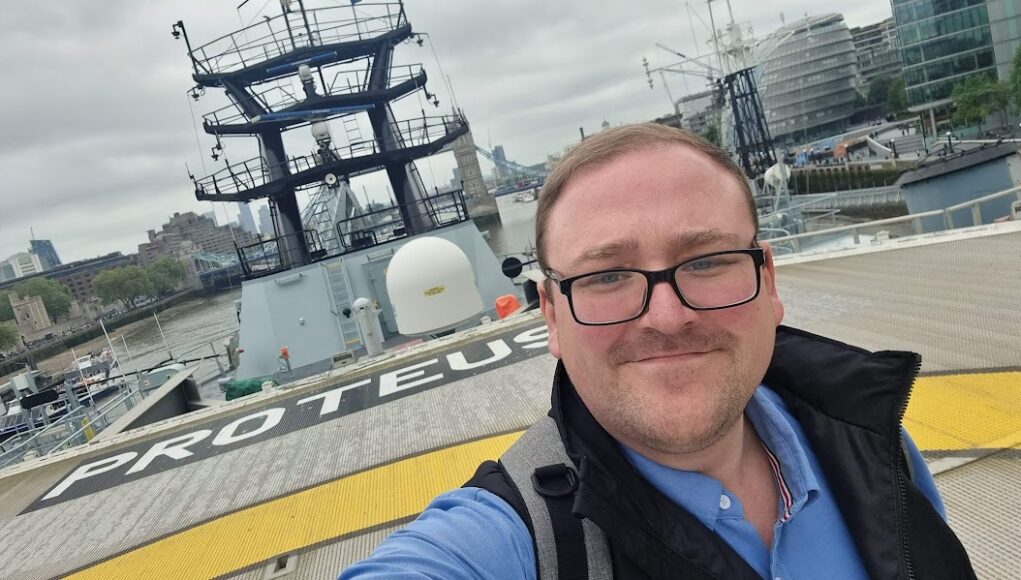
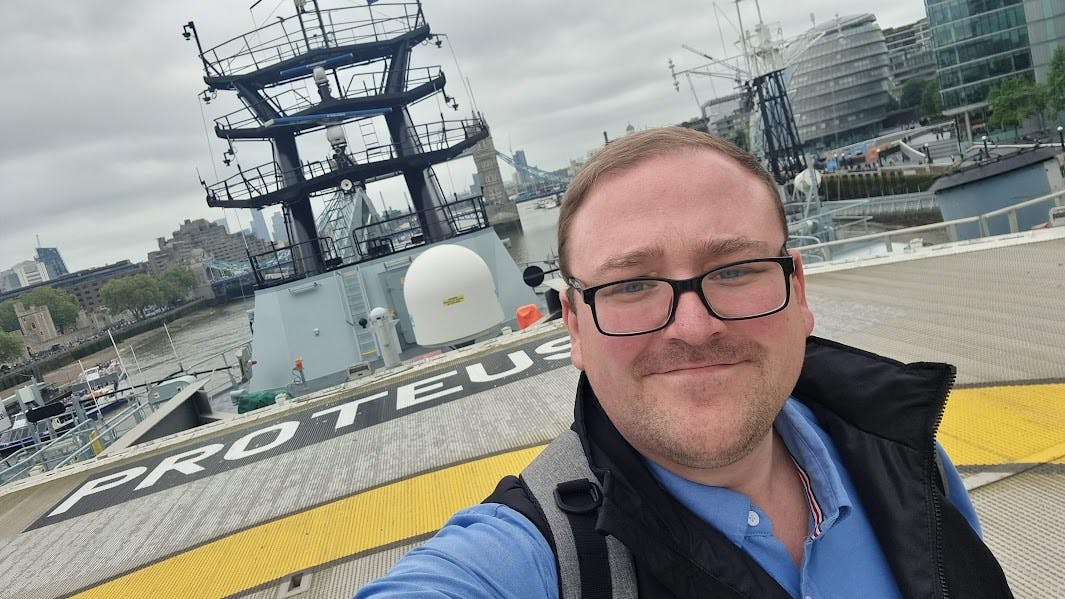
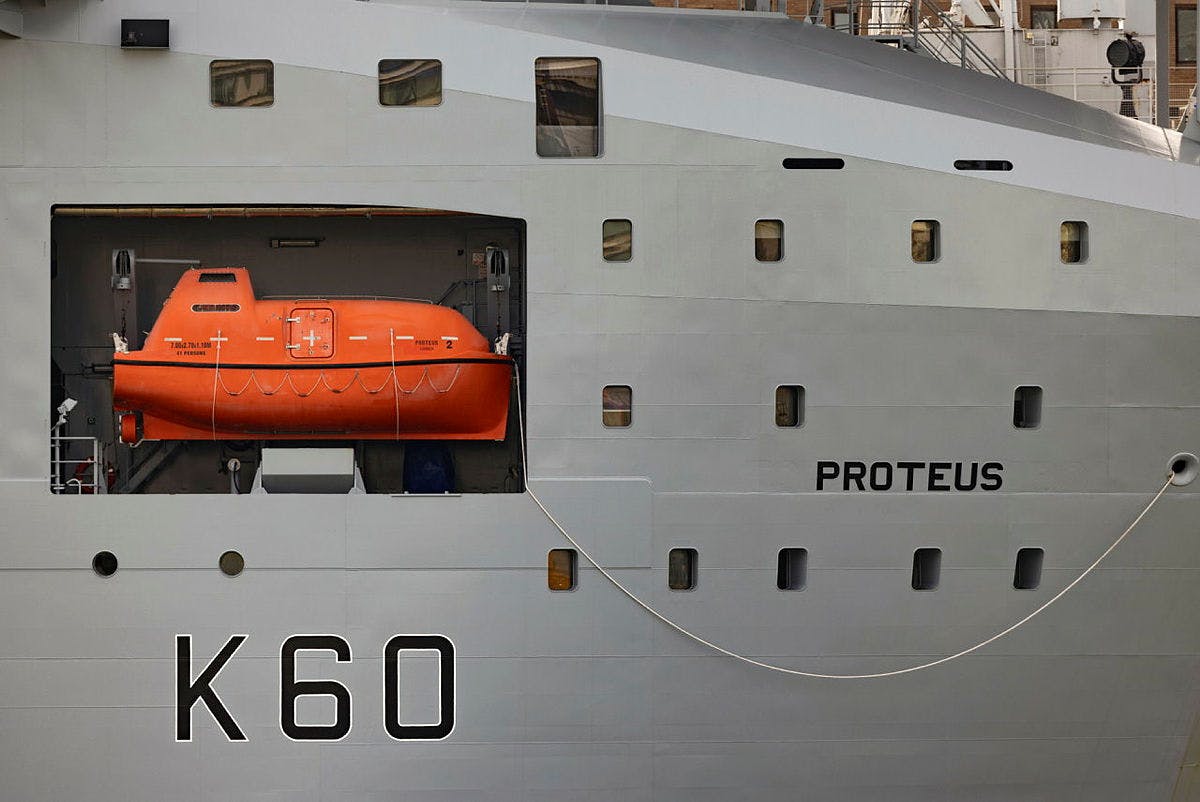
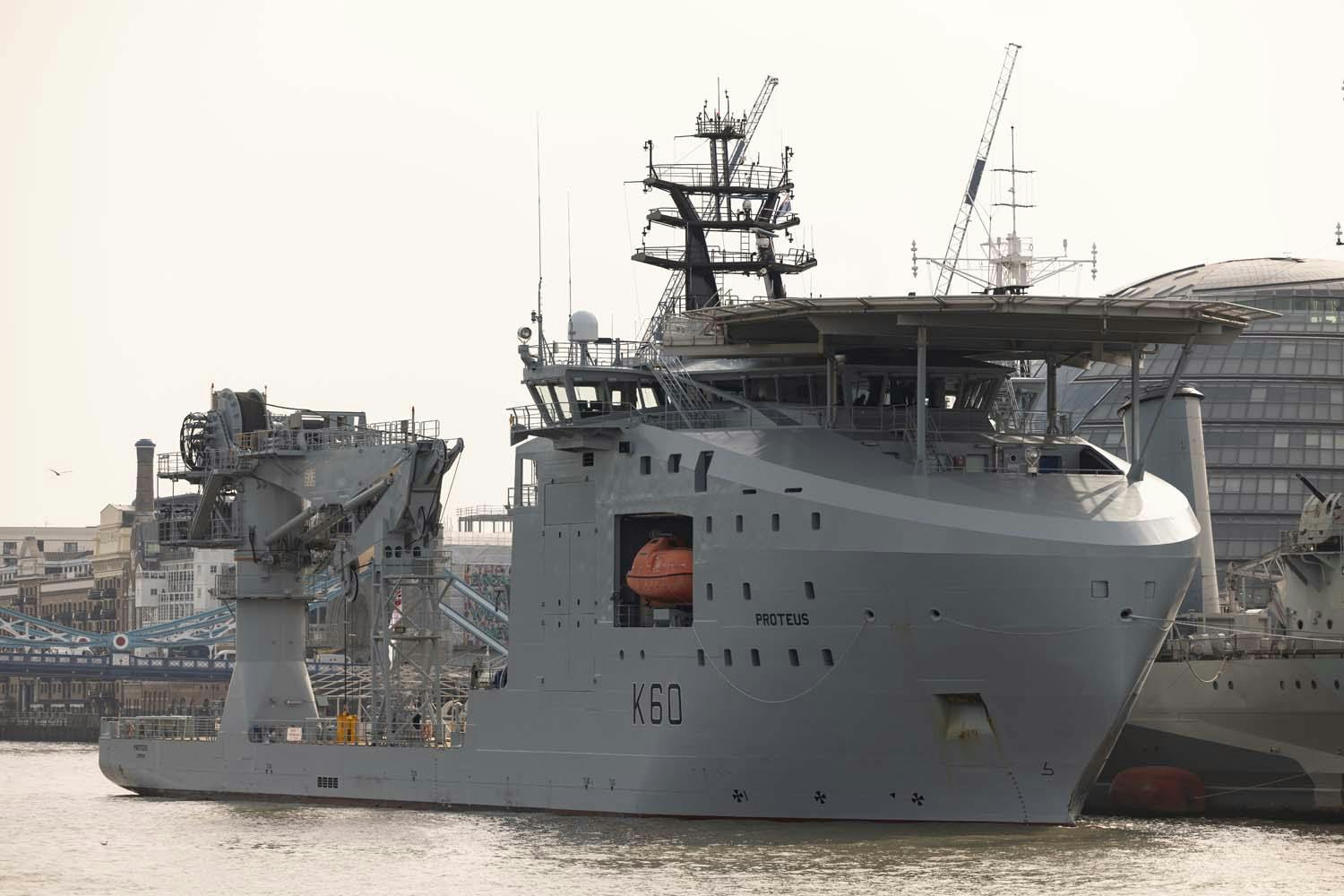
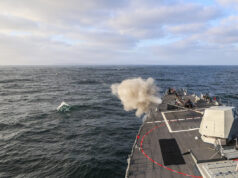
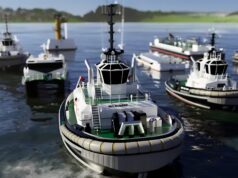
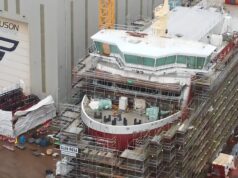
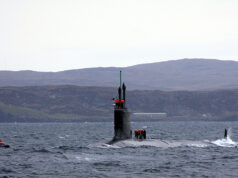
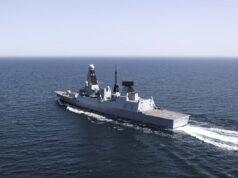

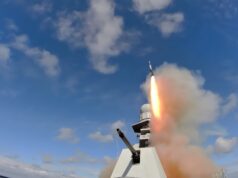
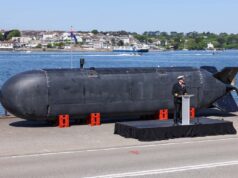
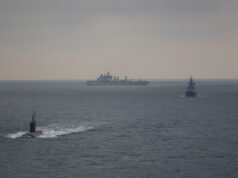
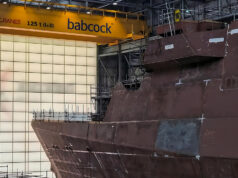

I knew someone who had been told they would be joining it months before its procurement became public knowledge.
They where going to remove the flight deck…sanity prevailed however and they kept it. OK its use is limited but it does have a use. SAR/CASEVAC and even useable by a drone in future.
Forget building dedicated milspec vessels such as these. Buy them from the market. Support is pretty straight forward. Plenty of small to medium ship repair yards can easily maintain, drydock and upgrade these vessels. Its not like OSVs are unique. They are used everywhere in the world.
I certainly think these vessels are the way to go for MCM and hydrography work. I wonder when they will be painting Stirling castle grey.
At the next refit I believe.
She wasn’t meant to be when we procured them as she’s not destined for hazardous operational areas and was meant to be run as commercially as possible. However that fell apart due to RN fingers getting into the pie. So wouldn’t be surprised if they waste money on making her ugly.
Bit of a tangent but has this ship got any armaments or decoys ability of any sorts?
No.
The navy pretty much don’t bother arming them usually,how they’re supposed to defend themselves is anybody’s guess. I mean look at the destroyers and frigates built since the 60s, criminally underarmed. The OPVs have size and space to put weapons on them and not a pathetic 30mm cannon. I’m pretty sure if Ukraine got hold of them they’d have SSMs and at the least a CWS. It makes my blood boil at who makes these decisions,who in the right mind thinks a 30mm is enough,and before anyone says but it’s a patrol boat,look at the swedes and Norwegian patrol boats,I’m sure they’d give our frigates and destroyers something think about
Maybe depending on the Yanks for fire power and protection. What is this shi really going to do, repair gas and oil pipelined. Maybe attack Chinese or Russian pipeline? Maybe send and recover SA attacks?
RFA’s generally are not supposed to defend themselves, they are civilian crewed, and only have Navy personnel on them to man the odd machine gun or act as boarding personnel.
(Oh and the whole OPV thing? It’s a such a tired horse that people complaining that a vessel that’s designed to be cheap to operate and maximise sea days is optimized towards maximising sea days and being cheat to operate has become practically a meme, suffice to say: No they really don’t need anything more than a 30mm).
For the Swedish Patrol boats; They consist of old corvettes that have been stripped down to become patrol boats (and they’re inshore patrol boats not ocean going ones). Effectively the Swedes took their old 300t Corvettes, ripped a gun and some AShM’s off it, and then used it as a cheap addition to their more modern Corvettes to patrol their Islands. Not analogous to a purpose built Ocean Going ship that’s meant to take up stations that do not require a full surface combatant. (Also not entirely convinced they’d give a Frigate with any sort of VLS farm much worry outside of the swedish islands with their big radar cross sections, and limited AShM’s).
Norway is closer to us, having built 3 really big OPVs (9000t displacement) for use in the arctic, but again, relatively lightly armed (They have 57mm put lack the sensor and CMS suite to utilise them effectively). Not even remotely a kind of ship that would give a T31 pause.
Er, try twin 20mm Vulcan Phalanx CIWS and semi automatic 30mm cannon, far more than the couple of GPMG that you wrongly allude to.
RFAs have a supporting role to the military, primarily the Royal Navy and therefore are supposed to defend themselves as they can end up in a hostile environment. The Falklands conflict is testament to this. Notably RFAs Sir Galahad, Sir Tristram, Sir Lancelot and Sir Bedivere. Galahad is now a war grave. RFAs are permanently operating in Arabian Gulf, Gulf of Oman and in waters off the southern Arabian peninsula and have to get there and back through one of the high risk pirate areas of the world. Yes, RFAs are civilian manned and are trained and operate some of the weapon systems. During times of conflict RFA crews sent to that area become reservists and are covered by the Geneva convention, the same as all other military personnel.
waste of more money.utterly daft oroteus finds something fishy going on what can it do? nothing. all it can do is phone the MOD and say boss there’s some russian thing messing about with the cables , what should I do? the answer is. nothing proteus just sail away and we’ll pretend nothing happened.
Fine for this task in a peacetime environment. More concerned about MCM mothers hips being non dedicated design.
MCM is something which mak have to happen in a contested littoral environment and we have no sensible plan to defend MCM assets from air attack, (nor have we since a non radar guided cannon ceased to be an effective air defence)
I can’t help thinking this solution is the cheap option…
The role should be undertaken by purpose built RN vessels design for warfare and crewed by RN not RFA…
I appreciate there was a need for speed in bringing them into service, but they should be a stop gap until the RN gets purpose designed ships for the role.
I do wonder why these are RFA. and not HMS? An RN crew of over 50 and an RFA crew of 26, with an operational role, surely they should be RN and allow those 26 RFA crew to reactivate laid up tankers?
Great report and very informative. The west needs more of these ships in their navies. Lot of sea to keep track of.
No Moonpool, George?
I’d read she has one.
Yep, just looked at NL and Wiki. Seems a more secure ( and covert ) way to deploy things than over the side.
Any images of the bridge? Just looked up the Castle Stirling, and it has a Kitchenette on the bridge. The bridge on the Italian PPA ‘Paolo Thaon di Revel’ looks pretty cool.
I think there’s an older atricle on Navy Lookout that has a few pictures of her bridge. Would link but that would put my comment into moderation.
Anyone who follows Sir H and the TPL on Twitter might have seen his revelations, via files released by the NA in Kew, on this ships predecesessor, HMS Challenger.
She indeed got up to a lot more than met the eye, which was long suspected. I’d hope RFA Proteus will behave similarly.
You follow Sir Humphrey as well 😉
Mate, HMS Challenger, back in the day, when I was just a teen studying this stuff, always fascinated me. “Survey” is a very convenient cover that is used by the military.
Good article George, converted commercial shipping please and let the RFA grow properly without the seniors in MoD making daft suggestions on equipment!!!!
Are ships! check your grammar please before publishing.
The original sentence, “The future of British seapower is ships like RFA Proteus,” is grammatically correct. Here’s why:
Subject-Verb Agreement: The subject “The future of British seapower” is singular, and the verb “is” correctly agrees with it.
Predicate Noun: The phrase “ships like RFA Proteus” functions as the predicate noun, explaining what “the future of British seapower” consists of.
accommodations? I know you know G!
The help deck can also launch sub hunting helicopters.
A new Labour Government and already Defence ‘cuts’ looming. No different to previous Labour Governments.
Pull the other one, did you really miss how the last Tory government gutted the army, and reduced the number of ships in every navy class to almost terminal levels?